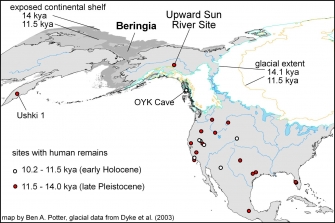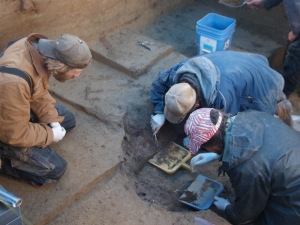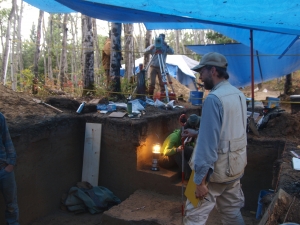Researchers at the University of Alaska Fairbanks recently recovered Pleistocene - or Ice Age - human remains and an associated residential structure at the Upward Sun River site located along the upper Tanana River in central Alaska. These discoveries are significant first finds for the eastern Beringia region, which encompasses Alaska and the Yukon Territory. Residential structures and human burials from the late Pleistocene and early Holocene are rare. None are previously known for the North American Subarctic and Arctic. The remains of a child who was cremated and buried, and the nearby residential artifacts, at the Upward Sun River site provide new cultural information regarding early Beringians.

A team led by Ben A. Potter of the University Alaska Fairbanks and funded by the National Science Foundation discovered the burial and house during a 2010 excavation. The excavation was designed to explore the earliest of several late Pleistocene occupations previously identified at the Upward Sun River site, also known as ‘Xaasaa Na.’ While excavating older materials, approximately 13,300 years old, the team found the cremated remains of a child within a pit-hearth. The child was approximately 3 years old at death. After consultation with local and regional Native groups, the team returned to the site in 2011 and found that the hearth was the central cooking hearth of a residential structure which was about 4 meters diameter. Several hundred fragments from stone-working were found in direct association with the residential features. These lithic fragments included several bifacial tools, which were probably used as knives. Radiocarbon dates place the find at 11,500 years old, making the Upward Sun River site one of very few Paleoindian structures in North or South America and the earliest in northwestern North America.
The Upward Sun River site provides data for a number of important problems regarding colonization of the New World and human adaptations at the Pleistocene – Holocene transition.
The residential structure is relatively small, suggesting small co-residing populations. The faunal remains indicate a wide diet breadth, including salmon, ground squirrel, hare, and birds. This can be contrasted with the Gerstle River site, a nearby early Holocene site dominated by weapons technology, including microblades and composite points, and faunal remains of exclusively large ungulates such as wapiti and bison.
Both the Upward Sun River and Gerstle River sites are technologically part of the Denali Complex. The new data suggests more realistic complexity in prehistoric settlement systems, technology, and subsistence economies than previously known. These discoveries indicated that facets of forager behavior were a condition of social context. Specifically the logistically organized hunting group(s), as represented at the Gerstle River site, were distinct and separate from a local foraging group, which included females and children, as represented at the Upward Sun River site. Interestingly, the site provides a glimpse of human activities in an area where relatively little is known about prehistoric adaptations. Combined with other inter-site evidence, the emerging patterns suggest complex adaptive strategies, where people adopted conservative yet flexible and resilient technological and settlement systems enabling them to cope with major climatic changes, including the cold and arid Younger Dryas and the subsequent Holocene Thermal Maximum.
For further information about these discoveries, please see: http://www.sciencemag.org/content/331/6020/1058.short or contact Ben Potter (bapotter [at] alaska.edu).


